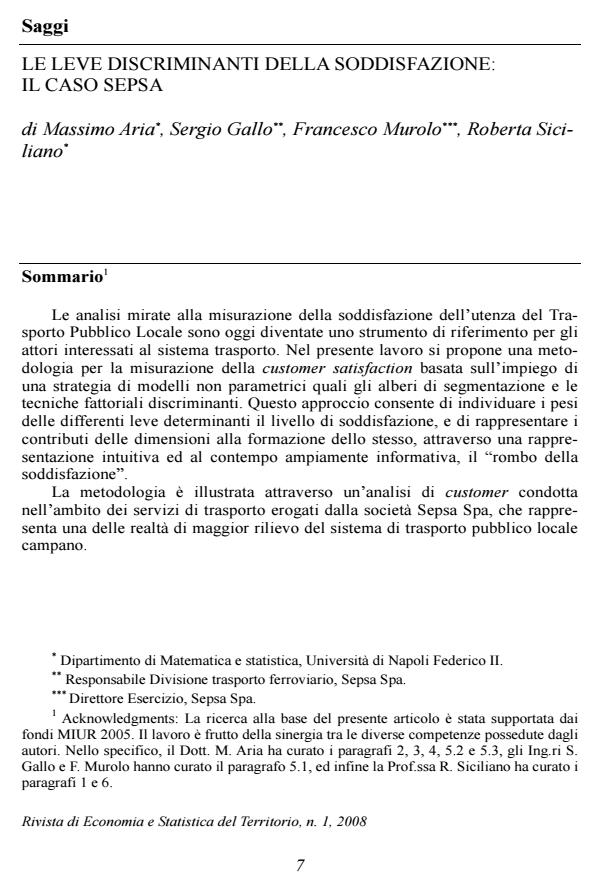Le leve discriminanti della soddisfazione: il caso Sepsa
Journal title RIVISTA DI ECONOMIA E STATISTICA DEL TERRITORIO
Author/s Massimo Aria, Sergio Gallo, Francesco Murolo, Roberta Siciliano
Publishing Year 2008 Issue 2008/1
Language Italian Pages 18 P. 7-24 File size 436 KB
DOI
DOI is like a bar code for intellectual property: to have more infomation
click here
Below, you can see the article first page
If you want to buy this article in PDF format, you can do it, following the instructions to buy download credits

FrancoAngeli is member of Publishers International Linking Association, Inc (PILA), a not-for-profit association which run the CrossRef service enabling links to and from online scholarly content.
The discriminant levers of customer satisfaction: the Sepsa case ABSTRACT: The discriminant levers of customer satisfaction: the Sepsa case Objectives The modern discipline of customer care is more and more paying the attention on the centrality to the customers in the modern business organization. In particular it deals with those rules, which with an increasing strength, intervene in the control of the economic activities. It is ever more true in the context of public goods, in which the attention to the consumers is hard deep-routed. As a consequence have been spreading some new initiatives, such as the service-charters, which impose to the suppliers of public goods/services the so called customer care. It is a set of actions concerning the contact, the involvement, the communication that form the main aspect of the public marketing. In this paper, to give an answer to this ethical but at the same time managerial demand, we propose a new methodology to measure the customer satisfaction (CS) based on the employment of a strategy of non-parametric models, whose aim is to individualize a set of optimal weights for the construction of a synthetic indicator of customer satisfaction. The knowledge of the role played by the latent dimensions of the satisfaction allows to support the management in the allocation of limited resources, typical of the budget of a public firm. Methods The Stump Two-Stage via Discriminant Analysis methodology, described in this paper, is based on an extension of the TS-Dis method proposed by Mola and Siciliano in 2002. The aim of this method is to identify the relationships between the typical dimensions of a public service, throughout the quantification of a set of optimal weights used to build up a global satisfaction index. In other words, starting from the data obtained trough a direct survey of customer satisfaction, the methodology makes use of a strategy of analysis which combines a non-parametric technique (two-stage segmentation trees) and a factorial method (linear discriminant function) to measure the importance of each dimension and each attribute, with the task to better explain the difference between clusters of satisfied and unsatisfied consumers. Conclusions This methodology has been showed by a CS survey carried out in the context of transport services supplied by Sepsa Spa company. It represents one of the most important actor working in the local transport system of the Campania Region. The obtained results have allowed us to identify the discriminant levers of satisfaction, which, in other words are the critical points of the service, where is necessary to invest in order to increase the level of satisfaction perceived by the users.
Massimo Aria, Sergio Gallo, Francesco Murolo, Roberta Siciliano, Le leve discriminanti della soddisfazione: il caso Sepsa in "RIVISTA DI ECONOMIA E STATISTICA DEL TERRITORIO" 1/2008, pp 7-24, DOI: